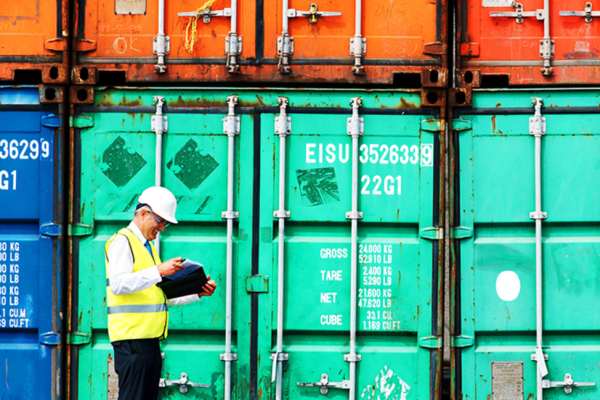Published on the 24/09/2018 | Written by Jonathan Cotton

IBM’s TradeLens hypes a step toward ‘one-touch’ international shipping…
There’s a metric tonne of optimism – not to mention investment – attached to all things blockchain. And one of the holiest of the blockchain holies is the long-imagined blockchain-enabled supply chain.
Such a project could revolutionise global freight logistics as we know it, providing hyper-efficient and secure global shipping, frictionless information sharing, unprecedented traceability and maybe just ushering in a new era of industry-wide innovation.
That’s now one step closer now with the news that IBM and Maersk have launched just such a portal, TradeLens, a blockchain-powered digital supply chain platform, which, if it does what it says on the tin, will unify the work of shippers, shipping lines, freight forwarders, port and terminal operators and customs authorities.
Using blockchain tech from IBM, TradeLens will give users across the shipping process access to a single, shared source of truth for international shipping transactions, and provide real time access to shipping data and documents – including IoT and sensor data ranging from temperature control to consignment location and container weight.
Trials have been underway for the last 12 months and in that time more than 154 million shipping events have been captured on the platform, with that data, according to IBM, growing at a rate of close to one million events per day (given it’s just launched, one suspects there may be an element of Maersk-directed traffic in those numbers).
It’s an ambitious project but not the only one of its type. Accenture is leading a Kuehne + Nagel/APL consortium (which, wisely, focussed on beer logistics); and ABP, the leading port operator in the UK, recently launched plans to investigate blockchain initiatives for British ports, similar to Port of Brisbane, and Singapore where the Open Trade Blockchain is exploring the opportunities.
So when can the trade sector down under expect to enjoy the benefits of such technology?
Not yet, but what we do have currently is the New Zealand Trade Single Window, a joint initiative between the New Zealand Customs Service and the Ministry for Primary Industries designed to let importers and exporters to meet multiple government regulatory requirements by submitting border clearance documents into a single system – not to mention streamlining at least some aspects of the Customs NZ mandate (sophisticated risk and intelligence engines are being rolled out currently).
“TSW provides much better quality information for New Zealand Customs, says Richard Bargh, Business Owner of the Trade Single Window at NZ Customs. “It makes it easier to identify what we want to look at, it provides better statistics, and it enables users to lodge one document and get clearance for four separate departments [Customs, MPI, Maritime New Zealand and the Ministry of Health].” Australian Customs is included in plans.
“It’s faster in terms of clearance time frames and we’ve opened it up to a number of different connection options.”
The “connection options” translate to import/export businesses and their export documentation solutions (such as CargoWise) connecting seamlessly with TSW.
Also built by IBM (and not without issues), the TSW went live in 2013 and while it does support multiple government agency requirements in New Zealand, it doesn’t include export and import processes between New Zealand and Australia – yet.
That’s a work in progress says Bargh, with New Zealand and Australia currently working through options to streamline trans-Tasman trade, including how export data can be used to support import clearance.
“TSW was developed to meet international data standards and therefore could potentially be used to translate export information from another country into import clearance information in New Zealand,” he says.
“However, the amount of data needed to clear goods for export in one country is usually significantly less than is needed to clear the goods for import in another country and further information would still be needed.”
Enter TradeLens’ blockchain, which, in theory at least, could be populated by data from CargoWise to inform the importing country’s clearance documentation requirements – automagically.
But that won’t be happening any time soon. Richard White, CEO of WiseTech Global (developer of CargoWise) says the company is a member on a few blockchain initiatives and commented that: “There are literally thousands of startups in blockchain – it is very over-hyped.
“The Maersk/IBM project is one of the projects we will track and if a customer perceives a need, we will jump in and do further work on it,” he said.
As for NZ Custom’s view on TradeLens, it’s a worthy endeavour says Bargh, but cautions that the prospect of a one-touch import/export solution is still in the realms of science fiction.
“You still need to load the information in some shape or form,” he says. “[TradeLens] offers people across the supply chain one view of what’s going to occur, but it’s not a one-touch platform. There is hype out there, but we’ve just got to be cautious about what it will deliver in the long term.”
“What it does do is give everyone involved the ability to see when a transaction has occurred, and that can be a problem in the industry, but our view is that there are different options available that already provide that. They may not be as trendy as blockchain, but there are providers who offer that service.”
“Having said that, anything the shipping industry does in this space is a vast improvement and anything that reduces any lack of certainty is a positive step.”



























